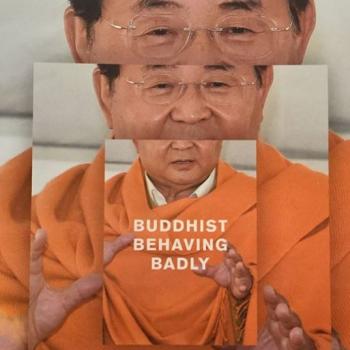
Yesterday, Bristol University’s Department of Theology and Religious Studies seminar hosted Dr. Sondra Hausner, who teaches anthropology at Oxford. Her talk, while very good, won’t exactly be the subject of my blog post today. But instead I thought I’d write about a few of the ‘spin off’ ideas that came to me out of her talk. [This is one of the things I’m very grateful for in academia, the opportunities one gets to hear leading researchers on countless topics and then to have a beer or glass of water with friends, or sometimes those very researchers, to discuss…] As with most spin offs, these are just preliminary and perhaps fragmentary notes…
- She mentioned a researcher* who had contrasted Patañjali’s highly mentalistic notion of yoga with the emphasis on bodily understanding found in Indus Valley Civilization (IVC) depictions of yoga (more images). This, according to her source, suggested the possibility of inversions of the prioritization of body or mind in certain practices (viz. yoga). Thus we can infer shifting understandings of what it would mean to be a yogi or yogini. This is fair enough, if the premises hold up. But what do we actually know about the Indus Valley Civilization’s emphasis, be it mental or physical, in yoga? Do we even know that they did yoga of any sort?
–
My understanding is that we just don’t know enough about the IVC to say such things for sure. Yes, we have plenty of fragments depicting people and animals and perhaps some form of rudimentary script (it has not yet been translated and some researchers believe it is not a script at all), but to suggest that we can judge how mental-vs-bodily oriented the people were is at best very speculative. I asked Dr. Hausner about this and she gave a good response, but offered nothing in particular beyond suggesting that the image might suggest a more bodily oriented understanding of yoga in the IVC.
–
“Speculative” still comes to mind for me, though. Without texts or a continuous tradition of any kind, it’s really difficult to say much about the theory or practice of people in the Indus Valley Civilization. On the one hand, from images, we have no idea what the practitioners are supposed to be thinking about, and on the other hand with texts, we often have no idea what the practitioner is doing. I’m reminded of the (also Oxford-based) anthropologist David Gellner’s work in Nepal, where he found that there was very clearly an insider-outsider relationship with texts, and that, first of all, outsiders weren’t expected to ever read the texts, and if they did read them, they most definitely couldn’t interpret them correctly because of the hidden symbolic language used. That was in the specifically tantric context, which is different from the yoga sutras, but you can see that there can be difficulty in exact understanding of a 2000 year old text and tradition, especially when we’re talking in…
– - Non-emic terminology. That means that we’re using our (etic) categories to define and characterize their practices. Mind and body simply aren’t Indian terms, nor are mental and physical, though we can find and use plenty of Sanskrit, Pali, etc that match up fairly well. Early Indians probably didn’t think in terms like our Western, post-Descartes, polarity of mind and body, that which thinks vs that which is extended in space. In fact, early Buddhist texts sometimes define rūpa (body or form) in terms of the experience of solidity and resistance. Elsewhere nāma (name, or the mental side) and rūpa are described as being like two sticks or reeds of grass leaning against one another for support – the image suggesting mutual dependence and explicit denial of Cartesian Dualism which is not based on a theory of mutual dependence and in fact Descartes struggles (humorously) to even show how the two substances can interact with one another. All this is to say that our search through old texts and images in search of ‘mentalistic’ vs ‘bodily’ prioritization is fraught with difficulties. But that’s not to say it can’t be done and, after all, it was just a single seminar paper and one cannot demand too much (and this wasn’t even the main topic of the paper!), so this shouldn’t be read as criticism of the paper or the various sources, but more of a warning to students/readers who may pick up bits here and there in the realm of…
– - Categories. One of the central themes of the paper was that the category “yogini” has existed for thousands of years in Indian culture despite the vicissitudes of what exactly the term meant. In fact in her field work she found that it could be a contested label when placed on any one woman – is she a yogini? a real yogini? My girlfriend was sitting next to me at the talk. She does yoga. Is she a yogini, a real yogini? Sensing this puzzlement in my mind (I imagine, or perhaps I was just getting an overly confused look on my face), my girlfriend smacked my leg. Oh, she’s a psychic too, definitely a real yogini.In any case, the category “yogini” lives on, despite fluctuation and contestation (perhaps, in fact, because of it – it was never reified, ossified, and forsaken).
–
Think about that for a minute. Then think about a funny Western word that is about 140 years old…. Buddhism. There are already folks out there who argue that you can’t talk about Buddhism, you have to talk about Buddhisms; or, more often, that you can’t talk about the Buddhist religion, you can only talk about Buddhist religions. To me, this “zzz-ing” of categories reflects more of a postmodern ideology than anything else. Some distinctions are useful, for instance Pure Land Buddhism vs Zen Buddhism. But to say “there is no Buddhism, only Buddhisms” seems simply vapid. Do people do this with other religions? “There is no Catholic Church, only Catholic Churches…” What, one for each building? Each Catholic person? As a warning against monolithic interpretations (which have occurred and will surely continue), this is fine, but beyond that, I don’t see the value in pluralizing our categories, as if that “zzz” confers special recognition of differentiation hitherto ignored or somehow overlooked.
– - The final point she brought up was the idea of differentiating between categories (she gave the example of a person claiming, “I am a Hindu”) and practices (what that person actually does) and going beyond them to experience. I think that’s an interesting idea, especially after Robert Scharf‘s heavy (some might say devastating) blow to the idea of experience in the study of religion: “Buddhist Modernism and the Rhetoric of Meditative Experience,” Numen 42, no. 3 (1995), pp. 228-283. Download PDF – see also “The Rhetoric of Experience and the Study of Religion,” in Cognitive Models and Spiritual Maps (…). Download PDF. It has been a few years, but as I remember, for Scharf all so-called experience is reducible to categories and practices. The idea of some ineffable experience which is somehow beyond the concepts (texts, oral teachings) and practices is mere rhetoric cooked up after Buddhism’s (primarily Zen’s) encounter with the West. But it seems that there is some experience, ineffable as it may be, through which the yogini transcends the category of woman, transcends gender – and yet the power she obtains as a yogini is hers precisely because of her (gendered) practices contravening social norms. Of course it is her practice in the context of sexist categories which allow this, but, I think Dr. Hausner was suggesting, this two-part approach doesn’t satisfy either the complexity of what the yogini herself must experience or the experience we (as devotees, I suppose) have in her presence, an experience which in fact gives her the power which is so essential to her being within the category.
That researcher is Thomas MacEvilly. One of his works can be viewed (in part at least) here: the Archaeology of Yoga.











